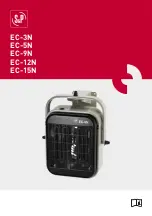
4
| CE CES CERO SERIES
WWW.STIEBEL-ELTRON-USA.COM
3. Functional
characteristics
CE/CES/CERO models are three-phase instantaneous electric water
heaters, intended for commercial use, permanently wired in Delta
or Wye configuration. Each series has models with power output
ranging from 12–144 kW.
CE models feature adjustable temperature output with a range of
90–185 °F (32–85 °C), user-adjustable in one degree increments (°F
or °C) via a push button switch (13).
CES models limit the output temperature according to OSHA require-
ments to a maximum of 90 °F (32 °C). They are factory set at a fixed
temperature of 85 °F (29 °C).
CERO models have the same temperature adjustment range as CE
models, but are designed for caustic liquids like salt water. To avoid
corrosion, titanium elements (1) are used instead of the standard
incoloy elements (1) found in CE and CES models.
CE/CES/CERO 12–18 kW models contain 3 heating elements, 24–36
kW models contain 6 heating elements, 48–72 kW models contain 12
heating elements, 81–108 kW models contain 18 heating elements,
and 120–144 kW models contain 24 heating elements. The elements
used in different configurations are for 208, 240, 277, and 288 V.
CE/CES/CERO models are available in a NEMA 3 (standard), a NEMA 4
(optional), or a NEMA 4X (optional) enclosure.
1 Element
2 Individual element thermostat/safety cut-off
3 Pressure sensor switch
4 Flow
sensor
5 Terminal
block
6 Electronic board PCB
7 Fuse
box
8 Pressure relief valve
9 Air
vent
10 Transformer
11 On/off indicator lamp
12 On/off switch
13 Temperature set switch
14 Ball valve, hot water supply side
15 Ball valve, inlet water supply side
16 Wire support
The heater’s outgoing water temperature is controlled with an elec-
tronic board (6) receiving sensor information from the flow sensor
(4), and an NTC sensor placed to detect incoming and outgoing water
temperatures. The element turns on once the flow sensor detects
a flow rate at or above the minimum activation rate. The board
calculates the necessary heating capacity, depending on required
temperature rise and flow rate.
Safety is provided by an individual thermostat/safety cut-off (2) for
each element, designed to avoid excessive heat buildup. A pressure
sensor switch (3) is installed in the first chamber to eliminate any
OPERATION
FUNCTIONAL CHARACTERISTICS





































